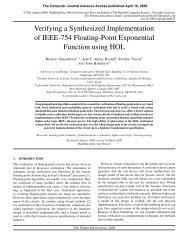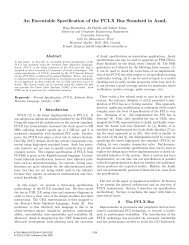PDF File - Hardware Verification Group - Concordia University
PDF File - Hardware Verification Group - Concordia University
PDF File - Hardware Verification Group - Concordia University
You also want an ePaper? Increase the reach of your titles
YUMPU automatically turns print PDFs into web optimized ePapers that Google loves.
•The Boolean layer is comprised of boolean expressions. For instance, A is a boolean<br />
expression, having the value 1 when signal A is high, and 0 when signal A is low.<br />
Sugar interprets a high signal as 1, and a low signal as 0, independent of whether the<br />
signal is active-high or active-low.<br />
•The temporal layer consists of temporal properties which describe the relationships<br />
between boolean expressions over time. For instance, always (req -> next ack) is a<br />
temporal property expressing the fact that whenever (always) signal req is asserted,<br />
then (->) at the next cycle (next), signal ack is asserted.<br />
•The verification layer consists of directives which describe how the temporal properties<br />
should be used by the verification tool. For instance, “assert always (req -> next<br />
ack)” is a verification directive that tells the tool to verify that the property always<br />
(req -> next ack) olds. Other verication directives include an instruction to assume,<br />
rather than verify, that a particular temporal property holds, or to specify coverage<br />
criteria for a simulation tool. The verification layer also provides a means to group<br />
Sugar statements into verification units.<br />
•The modeling layer provides a means to model behavior of design inputs, and to<br />
declare and give behavior to auxiliary signals and variables. The modeling layer is<br />
also used to give names to properties and other entities from the temporal layer.<br />
Sugar comes in three flavors, corresponding to the hardware description languages<br />
Verilog and VHDL, and to the language EDL [17], the environment description language<br />
of IBM's RuleBase model checker. The flavor determines the syntax of the<br />
boolean and modeling layers. In all three flavors, the temporal layer and the verification<br />
layer are identical.<br />
4.4.2. OpenVera-Forespec Proposal<br />
OpenVera-Forespec proposal was advanced by Synopsys Inc. and Intel Corp as a candidate<br />
for an industry-standard assertion language. The proposal was denoted as OpenVera<br />
2.0 [38], which includes Intel's ForSpec property language [4]. This quite strong proposal<br />
was rejected because it was very formal and too complicated for engineers to use it!<br />
OpenVera 2.0 is based on OpenVera 1.0 [40] and ForSpec. OpenVera 1.0 is an opensource<br />
verification language managed by Synopsys which already had an assertion capability<br />
for simulation. With the addition of ForSpec, OpenVera 2.0 supports formal verification<br />
tools as well. The whole concept in this combination was to have one language that<br />
supports both simulation and formal verification. ForSpec is a formal-property language<br />
used primarily by systems architects.<br />
But the main additions to the previous version of Vera are new constructs and operators<br />
that support formal verification tools. In addition to formal operators, ForSpec brings<br />
directives such as "assume," "restrict," "model" and "assert" that are aimed at formal verification<br />
tools. An "assume-guarantee" construct lets assertions be used as module-level<br />
properties become monitors at higher levels of hierarchy [6].<br />
The OpenVera Assertion (OVA) [6] language was developed to describe accurately and<br />
concisely temporal behaviors that span multiple cycles and modules of the device under<br />
26





